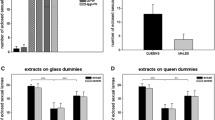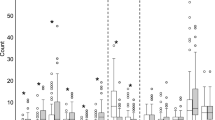Summary
-
1
The egg sequence at 20° C after hibernation of a queenMyrmica rubra L. has the following peculiarities:
-
a)
rate of production rises during the first 3 weeks to a maximum that is held for 3–4 weeks and then declines gradually to zero after 16 weeks;
-
b)
egg size declines during the period of increasing rate but then stays at a steady minimum value;
-
c)
worker-biased eggs are amongst those laid when rate is approaching its maximum and size its minimum. Other eggs, both the large first ones and the normal later ones enter diapause under the same culture conditions.
-
2
Queens may either yield a lot of worker-biased eggs or very few. Both types of queen may occur in the same colony or colonies may have a single type, and intermediates may be rare. The difference appears to be due to age for young queens lay a very high proportion of worker-biased eggs. Moreover such queens have a negligible social influence on brood-rearing compared with old queens.
Résumé
-
1
A 20° C après l'hibernation la séquence des œufs d'une reineMyrmica rubra L. montre les particularités suivantes:
-
a)
le taux de production s'élève pendant les trois premières semaines jusqu'à un maximum. Ceci se maintient pour 3–4 semaines, puis décline peu à peu jusqu'à zéro après 16 semaines;
-
b)
la dimension des œufs décline pendant la période quand le taux s'augmente, puis reste à une minimum valeur constante;
-
c)
les œufs prédisposés à devenir ouvrières sont parmi ceux pondus quand le taux s'approche du maximum et la dimension s'approche du minimum. D'autres œufs, les plus gros pondus en premier et les normaux qui viennent plus tard, entrent en diapause dans les mêmes conditions de culture.
-
2
Les reines peuvent donner ou beaucoup ou très peu d'œufs prédisposés à devenir ouvrières. Les deux types de reine peuvent se trouver dans la même colonie, ou les colonies peuvent en avoir seulement un type, et les intermédiaires peuvent être peu nombreux. La différence paraît être dû à l'âge, car les jeunes reines pondent une très grande proportion d'œufs prédisposés à devenir ouvrières. De plus, ces jeunes reines ont socialement une influence négligeable sur l'élevage du couvain en comparaison des vieilles.
Sommario
-
1
Il seguito delle uova a 20° C dopo l'ibernazione di una reginaMyrmica rubra L. mostra le particolarità seguenti:
-
a)
l'andamento di produzione s'aumenta durante le tre prime settimane fino ad un massimo. Questo si tiene per 3–4 settimane, poi declina poco a poco fino a zero dopo 16 settimane;
-
b)
la grandezza delle uova declina durante il periodo quando l'andamento s'aumenta, poi rimane ad un valore costante minimo;
-
c)
le uova inclinate a divenire operaie sono fra loro fatte quando l'andamento s'avvicina al massimo e la grandezza s'avvicina al massimo e la grandezza s'avvicina al minimo. Altre uova, le prime grandi e le normali di puì tardi, entrano nella diapausa sotto le stesse condizioni di coltura.
-
2
Le regine possono dare o molte o poche uova inclinate a divenire operaie. I due tipi di regina possono trovarsi nella stessa colonia, o le colonie possono contenere soltanto uno tipo; le intermedie possono essere scarse. La differenza sembra doversi all' età, piochè le regine giovani fanno una grande proporzione di uova inclinate a divenire operaie. Di puì, queste regine hanno uno influenza sociale negligibile sull' allevamento della covata a petto delle regine vecchie.
Similar content being viewed by others
References
Bier (K.), 1952. — Beziehungen zwischen Nährzellkerngrösse und Ausbildung ribonukleinsäurehaltiger Strukturen in den Oocyten vonFormica rufa rufo-pratensis minor Göss.Verh. dtsch. Zool. Ges.,24, p. 369–374.—Bier (K.) 1954. Uber den Saisondimorphismus der Oogenese vonFormica rufa rufo-pratensis minor Göss und dessen Bedeutung für die Kastendetermination.Biol. Zbl.,73, p. 170–190.—Bier (K.) 1958. Die Bedeutung der Jungarbeiterinnen für die Geschlechtstieraufzicht im Ameisenstaat.Biol. Zbl.,77, p. 257–265.
Brian (M. V.), 1951. — Summer population changes in colonies of the antMyrmica.Physiologia comparata et Oecologia,2, p. 248–262.—Brian (M. V.) 1962. Studies of caste differentiation inMyrmica rubra L., 5. Social conditions affecting early larval differentiation.Insectes Sociaux,9, p. 295–310.—Brian (M. V.), 1963. Studies of caste differentiation inMyrmica rubra L. 6. Factors influencing the course of female development in the early third instar.Insectes Sociaux,10, p. 91–102.
Brian (M. V.) andBrian (A. D.), 1949. — Observations on the taxonomy of the antsMyrmica rubra L. andM. lævinodis Nylander.Trans. R. ent. Soc., Lond.,100, p. 393–409.
Flanders (S. E.), 1957. — Regulation of caste in social Hymenoptera.J. N. Y. ent. Soc.,65, p. 97–105.—Flanders (S. E.) 1962. Physiological prerequisites of social reproduction in the Hymenoptera.Insectes Sociaux,9, p. 375–388.
Holldobler (B.), 1962. — Zur Frage der Oligogynie beiCamponotus ligniperda Latr. undC. herculeanus L.Z. angew. Ent.,49, p. 337–352.
Ledoux (A.), 1954. — Recherches sur le cycle chromosomique de la fourmi fileuse Œcophylla longinoda Latr.Insectes Sociaux,1, p. 149–175.
Lees (A. D.), 1955. —The physiology of diapause in arthropods. Cambridge University Press.
Author information
Authors and Affiliations
Rights and permissions
About this article
Cite this article
Brian, M.V., Hibble, J. Studies of caste differentiation inMyrmica rubra L. Ins. Soc 11, 223–238 (1964). https://doi.org/10.1007/BF02222675
Issue Date:
DOI: https://doi.org/10.1007/BF02222675




